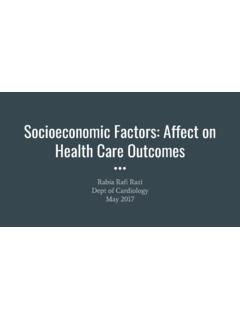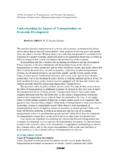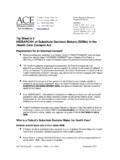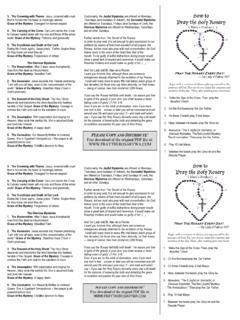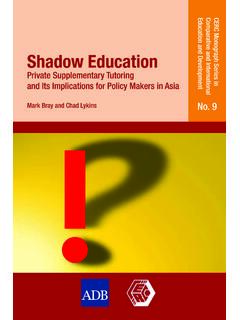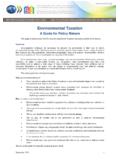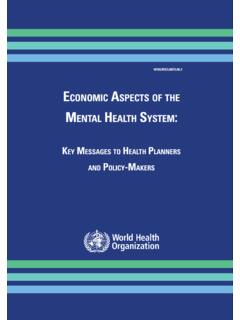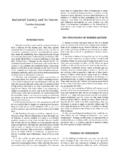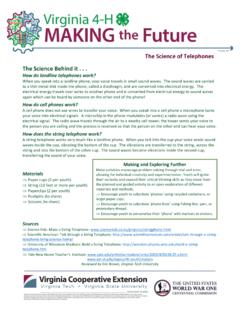Transcription of Health policy analysis: a simple tool for policy makers
1 Health policy analysis: a simple toolfor policy makersT. Collins*Department of Global Health , School of Public Health and Health Services,The George Washington University, Washington, DC, USAR eceived 26 August 2003; received in revised form 10 February 2004; accepted 23 March 2004 Available online 18 October 2004 KEYWORDSH ealth policy ; Policyanalysis; HealthoutcomesSummaryPolicy analysis is not an easy task. Its scope is broad and can include both theanalysis of policy process and the analysis of policy content. This paper is concernedwith the analysis of policy content and offers some practical guidance regarding how toanalyse Health policy and link it to Health outcomes. An eight-step framework forpolicy analysis is proposed that public Health policy makers and public healthpractitioners may find especially useful due to its The Royal Institute of Public Health . Published by Elsevier Ltd. All analysis can be a troublesome task. Its scopeis broad and problems can arise when decidingwhich aspects of policy to analyse.
2 Much academicwork, for example, focuses on the analysis of majorstakeholders and their influence on decision mak-ing. But what are the options that policy makersface, and which of them will result in desirableoutcomes? What are the consequences of policies ifthey are implemented?.In looking at policy analysis, an importantdistinction should be made between analysis ofpolicy process and the analysis of policy main focus of process analysis is policyformulation and the main focus of content analysisis the substance of policy . Content analysis exam-ines a significant policy issue and explores theoptions to tackle this paper is concerned with the analysis ofpolicy content and offers some practical guidanceregarding how to analyse policy and link it to healthoutcomes. policy analysis illustrates the need forinterventions that highlight and address importantpolicy issues, improve the policy implementationprocess and lead to better Health paper will begin by defining the terms policy analysis and Health policy , and willexplore different approaches to public policyanalysis.
3 It will also offer a framework for healthpolicy analysis that could be a useful tool for policymakers due to its approaches to policy analysisPolicy analysis is a generic name for a range oftechniques and tools to study the characteristics ofestablished policies, how the policies came to beand what their consequences are. Although increas-ing in importance in academic circles, policyanalysis is not yet considered a unified field ofPublic Health (2005)119, 192 1960033-3506/$ - see front matterQ2004 The Royal Institute of Public Health . Published by Elsevier Ltd. All rights *Address: 4515 Willard Avenue, Suite 2014, Chevy Chase, MD20815, USA. Tel.: main concern of policy analysis is theoutcomes of Health policies or the effects that thepolicy has on are different methodologies for publicpolicy analysis. Dunn suggested that policy analysisshould incorporate five general procedures commonto most efforts at human problem solving: defi-nition; prediction; prescription; description andevaluation.
4 Definition provides information aboutthe conditions that contribute to a policy provides information about futureconsequences of acting on policy alternatives,including doing nothing. Prescription providesinformation about the relative value of these futureconsequences in solving the problem. Descriptionprovides information about the present and pastconsequences of acting on policy , evaluation provides information about thevalue or worth of these consequences in solving referred to the three approaches ofpolicy analysis: policy making; cause and conse-quence; and the policy policy making approach to policy analysisdefines public policy not as a product of govern-ment action but as a political process. A proposalmust move through the following five stages tobecome a policy : problem formation; policy formu-lation; policy adoption; policy implementation andpolicy cause and consequence approach to policyanalysis is focused on intended or unintendedimpacts of governmental decisions or non-decisions.
5 It uses terminology from system analysis,such as inputs, outputs and prescription looks ahead. It attempts touse a variety of economic, mathematical, computerscience and operations research techniques toanswer the question: what should the governmentdo in the future?Pal offered a broader but brief definition ofpolicy analysis: the disciplined application ofintellect to public problems .5 Since it focuses onbroad questions and on the future, policy analysisis subject to considerable uncertainty. According toBardach, policy analysis is more art than science. Itdraws on intuition as much as method. Bardachproposed a practical framework for public policyanalysis, which he referred to as the eight-foldpath . The following eight steps form the bases ofthe path: (1) define the problem; (2) assemble theevidence; (3) construct the alternatives; (4) selectthe criteria; (5) project the outcomes; (6) confrontthe trade offs; (7) decide; and (8) tell your worth noting that going through these steps is notnecessarily a linear process.
6 Often, it can beiterative. Bardach s framework does not requiresophisticated methods of analysis; it is focused onthe policy issue and can be accomplished by policymakers in a relatively short period of policy analysisThe different policy analysis methodologies aboverefer to general public policy analysis, but how doesone go about analysing Health policies? At theoutset, it is important to understand what is meantby Health policy . The World Health Organization(WHO) defined Health policy as an agreement orconsensus on the Health issues, goals and objectivesto be addressed, the priorities among thoseobjectives, and the main directions for WHO s approach to public Health policy puts Health on the agenda of policymakers in allsectors and at all levels, directing them to be awareof the Health consequences of their decisions and toaccept their responsibilities for Health .8 However, Health policy decisions are not always the result of arational process of discussion and evaluation of howa particular objective should be met.
7 The context inwhich the decisions are made is often highlypolitical concerning the degree of public provisionof Health care and who pays for it. Health policydecisions also depend on value judgements, whichin any society are implicit, but are very importantto understand in order for policy to beimplemented, for example, the value placed onwomen and their differentiated policies by dividing them into high politics and low politics . High politics issuesor macro-policies (such as major economicdecisions or national security) involve the long-term objectives of the state and those in power, asopposed to low politics issues or micro-policies thatinvolve mainly sectoral interests. In Health , manypolicies often fall into the category of low , as Walt stated, a low politics issue canshift and become a high politics issue over time. Ahealth policy maker needs to be aware of theseconstraints and develop a sense of what is urgentand policy analysis is a political as well associal activity and could be very time , in today s fast-paced environment, Health policy makers may face a daunting realityof having to make important decisions in a veryshort period of time.
8 Most frameworks proposed inthe Health policy literature use particular conceptsand models in order to explain Health policies inabstract, theoretical terms and focus mainly onHealth policy analysis: a simple tool for policy makers193macro-analysis of political systems, including therole of the state. This paper proposes a moresimplified framework for Health policy analysis forpolicy makers who need to make decisions on healthissues. The framework is adapted from Bardach andoffers step-by-step guidance for policy analysis thatwill be very valuable for practitioners who do nothave much time, resources and/or experience inconducting policy analysis studies. The followingsteps comprise the suggested framework: (1) definethe context; (2) state the problem; (3) search forevidence; (4) consider different policy options; (5)project the outcomes; (6) apply evaluative criteria;(7) weigh the outcomes; and (8) make the 1. Define the contextCountries vary enormously in terms of geography,politics, economics, culture and the organization oftheir Health systems.
9 In every country, Health policymirrors political, economic and social pressures, aswell as national values and priorities. Health policyanalysis has utility to the extent that it looks athealth policy in the context of these nationalrealities. Therefore, the first step to take in policyanalysis is to develop a comprehensive profile of agiven reasons for profiling a country for thepurposes of policy analysis are two-fold: (1) toprovide the background information on the countrythat puts Health policy in context; and (2) tounderstand the determinants of Health problems(socio-economic, cultural) that will subsequentlyform the basis for Health policy developing a country profile, it is useful tolook at all the factors that directly or indirectlyinfluence Health policies. The range of contextualfactors that affect policies are broad and couldinclude country history (political system, othernations influence), geography, social and econ-omic conditions etc. Leichter proposed four cat-egories of factors that have impact on policies:situational factors (such as violent events or changeof government) that are more or less transient;structural factors (political structure, economics,social systems) that are relatively permanentcharacteristics of a given country; cultural factors(values of society) and environmental factors,11which Walt called external or international struc-tural factors (trade agreements, influence ofbilateral and multilateral organizations).
10 10 Healthproblems do not arise in a vacuum and changes inany of the contextual factors usually have direct orindirect influence on the Health status of thepopulation, which is important to 2. State the problemThe next step in Health policy analysis is consistentwith Bardach s first step defining the healthproblem. The Health problem is a situation orcondition that has a current or potential adverseeffect on people s Health . Whether a problemrequires research depends on three conditions, There should be a discrepancy between whatexists and the ideal or planned The reason for this difference should be There should be more than one possiblesolution to the effort to define a Health problem leadsnaturally to a problem statement. A good problemstatement should be limited to description. Pro-blem statements that explicitly or implicitly alsoinclude a diagnosis of the causes of a problem canbe order to develop a well-definedhealth problem statement, data are needed on apopulation s vital statistics (live births, deaths byage, sex and cause etc.)
